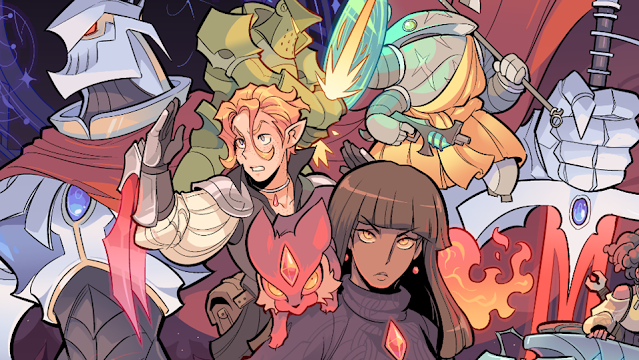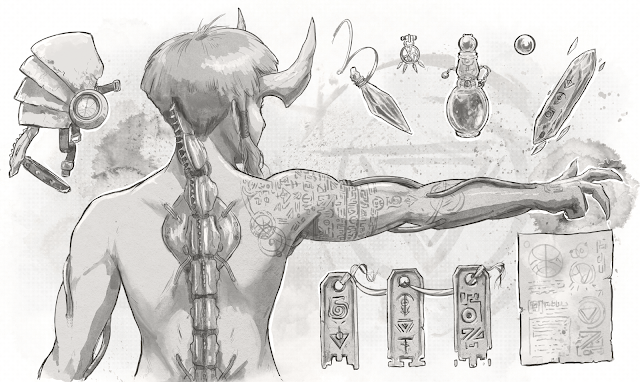If you're new here, quick update: I love love love giant robot anime. I worked on Discotek's DVD release of Mazinger Z. My fellow Crunchyroll newsroom writers save mecha anime news for me in the morning. (And yes, I'm aware of Brave Bang Bravern. We'll talk about that another time.) So when my Sunday game finished our year-and-a-bit D&D campaign and the DM wanted to try a new system, and happened to mention this one, I was hype.
Two sessions in? Still hype. And I will absolutely revisit my experiences with this at the end of the campaign, but I want to give a beginner's view of what it's like to play and, if you're a hopeless mecha addict like me, how much it will vibe for you.
To start, Armour Astir: Advent is a Powered by the Apocalypse game. (Think Blades in the Dark or Monster of the Week: playbooks fitted to genre archetypes, story progression over hit point counting, and d6es only.) PBTA games have their share of ups and downs, and while the system is constructed in a way that eases party/game setup and story flow, your mileage may vary based on your goals in tabletop games. I've found myself warming to this style of game over time as I get more acclimated to it.
The one issue I've had with other PBTA games is that sometimes, the thing you want to do doesn't have a clear stat attached to it, and thus there's a lot of hemming and hawing over how to account for the dice-rolling aspect of your next Move. In Armour Astir, at least for Channelers (more on that in a second), there's literally a move and a stat for that: "Weave Magic," i.e. "anything that goes above and beyond everything on your sheet." Which I think is pretty great.
The game is inspired by a mishmash of robot anime, fantasy anime, and fantasy in general. Relevant titles are listed in the source book, but if you're anything like me, you'll likely catch the references in the names of Moves and the descriptions of things overall. And the writers really know their stuff: the tropes run deep, and players are encouraged to play with what they mean from a character standpoint.
Case in point, the Impostor playbook (i.e. the one I'm playing). This one jumped out at me for two reasons. For one, it's the most rooted in the hot-blooded shouty delinquent super robot pilot vibe I love so much. For another, "Impostor" refers to the fact that these characters channel magic not through study or faith or some other aptitude, but through body modifications. Players are encouraged to approach this through the lens of disability or dysphoria. And as someone who spent half my life dealing with debilitating chronic pain, I chose the former. The book says that your augmentation does not make your life more difficult unless you want it to, and for the purposes of this character I want it to.
Without going into a whole long diatribe on my character and what makes her tick, I will say that my experience building an Armour Astir character has been much more in-depth than any other PBTA games. Interrogating the deeper meaning of a certain play style is something I try to do with all my characters, but this is the first time a book has ever outright said "Please go there."
Similarly, each playbook comes with a unique Gravity trigger. Gravity is a stat that measures the relationship between you and other characters, be they PCs or NPCs. This could be romance, friendship, uneasy alliances, a desire to absolutely murder each other, etc. Besides being a great way to measure and keep tabs on the pacing of story threads, I really appreciate that it's a concrete way to tell the GM, "I would like to focus on the chemistry between these two characters, please." I've been gaming for years and I still do a bad job sometimes of voicing when I want to chase down a plot thread.
More things I love, in quick succession:
- There's plenty for non-Channelers to do. Our party is made up of two Channelers and two Support, and I've been enjoying seeing how their abilities and contributions to the party build out. Nowhere do the Support characters feel at all lesser or underpowered.
- One of my favorite things about PBTA games is that you're rewarded for enduring difficulties in the game. (XP for failure in Monster of the Week, XP simply for having to make Desperate rolls in Blades in the Dark.) In Armour Astir, failing rolls stack into something called Spotlight. You can use those to advance, or you can spend six Spotlight in the moment to do something really cool. As a serial Bad Roller, I appreciate anything made to soften the blow of RNG failure at table. Not to mention it fits into the hot-blooded eleventh hour action I love so much.
- While I didn't see it listed under the inspirations, I get a lot of Super Robot Wars vibes off this game. (Which is to be expected.) This feels especially evident in the Impostor playbook, where your Channel stat increases as you take hits, to the point that it behooves you to save your big badass moves for when you're about to take a knee.
One last thing that deserves its own space: I appreciate that this game acknowledges more interesting risks than simply death. As someone who delved deeper into gaming as a way to get back into the world after a death in the family, and as someone who does this largely to exercise the creative part of my brain and get back to storytelling consistently, I'm not a fan of player character death being solely at the whim of the dice. (If others are, that's fine, but I believe players and DMs should decide this before playing.)
In Armour Astir, when your character Bites the Dust, they're out of the sortie. Based on the next set of rolls, they might recover unexpectedly well, or they might carry that defeat with them in some way. To me, that's so much more interesting and compelling then saying "Too bad you failed at rolling, your character's story is just done now." That's the main reason I've warmed to PBTA games recently: instead of it being a Session 0 discussion, defeat as transformative rather than subtractive is baked directly into the system.
As I said, I'm only two sessions in. We're all learning together as we go, figuring out how everything works. One of our players is even trying out a playbook from the expansion. When we're further in, or perhaps at the end of the campaign, I intend to report back with more.
Check out Armour Astir: Advent, eight addition playbooks in Armour Astir: Encore, and romance expansion Amor Astir at Briar Sovereign's itchi.io page!



0 comments:
Post a Comment